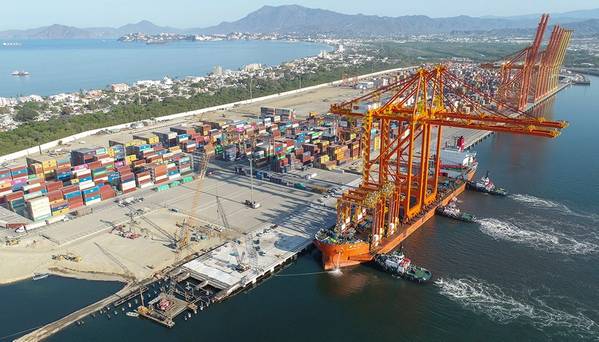
Contecon Manzanillo (CMSA), ICTSI’s Mexican business unit and operator of the Second Specialized Container Terminal at the Port of Manzanillo, has acquired two quay cranes and four hybrid rubber tired gantry (RTG) cranes.
At 60 meters high, the quay cranes are the largest in the Americas. They enable agile and efficient operations on vessels up to 400 meters long with beams of more than 60 meters. The acquisition is part of the ongoing terminal expansion and supports CMSA’s goal of handling more than two million TEUs annually.
The cranes also mark a crucial step toward increasing Mexico’s global competitiveness and consolidating the Port of Manzanillo as a national leader in port operations, says ICTSI. Once fully commissioned, the cranes will enable CMSA to simultaneously handle three ships with length overall of up to 400 meters each – effectively raising the standard of port operation in the region.
“By acquiring new port equipment and strengthening our infrastructure, we reaffirm our commitment to Mexican foreign trade and consolidate our position as one of the country’s leading logistics platforms,” explained José Antonio Contreras, CMSA chief executive officer.
CMSA’s expansion project also includes infrastructure upgrades that will enable the terminal to accommodate up to 24,000-TEU capacity megaships. The new berth, which will be completed in the coming months, is designed to handle vessels with drafts of -17 meters. This will give a competitive and operational advantage that will maximize the cargo capacity of ships crossing the Pacific from Asia. The Port of Manzanillo handles 70% of imports from Asia.
“Thanks to our strategic investments, we increased our operational capacity leading to 14% growth in 2024, moved 1.5 million TEUs, and contributed to the economic development of Manzanillo and Mexico,” added Contreras.
CMSA’s total investments from 2023 to 2026 will reach more than $300 million. The company will continue to allocate the needed resources to improve the terminal’s operation and ensure Mexican foreign trade access to the Pacific logistics routes, where shipping lines have increasingly deployed larger, deeper-draft vessels.


